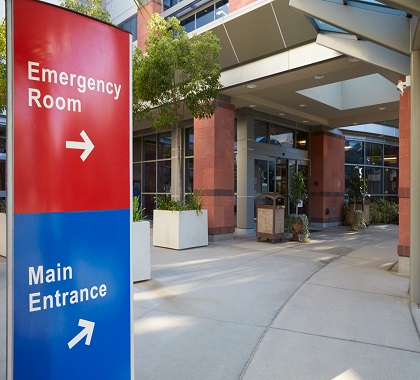A new study released in The New England Journal of Medicine (NEJM) used data from the State of Oregon’s Medicaid experiment to determine the effect Medicaid expansion has had on the number of visits patients have made to emergency rooms. The Oregon program implemented a limited expansion of Medicaid for lower-income non-disabled adults using a lottery system. Because the government in assigned spots in the program randomly, researchers say the experiment is a good model to analyze.
Affordable Care Act (ACA) architects argued when crafting the legislation ensuring everyone has a health insurance plan would encourage patients to take advantage of traditional preventative care, instead of relying so heavily on emergency rooms (ER). Since ACA was implemented, however, the opposite has been true: The NEJM study found Medicaid expansion increased ER visits by 40 percent in the first 15 months. The authors also say their research shows the increase was not due to pent-up demand and that it is not clear patients using Medicaid replaced ER trips with trips to a physician’s office.
The use of the emergency room for non-emergency care is disruptive for several reasons: Costs are much higher in an emergency room, care is often provided less efficiently, and ER doctors are typically generalists with less experience providing non-emergency care. Also, waiting times are often excessive, which limits access to care.
The NEJM study echoes the findings made by other researchers who have studied ACA-related ER survey data. According to a 2015 survey of members of the American College of Emergency Physicians (ACEP), the number of emergency room visits by low-income patients has increased since Obamacare went into effect,
The ACEP study found noticeable increases in the number of people seeking ER care. Three quarters of the 2,099 doctors surveyed said they witnessed increases in the number of patients using ER services. Forty-seven percent of those responding to the ACEP poll saw a slight increase and 28 percent reported a large increase. Fifty-six percent found an increase in the number of Medicaid patients using emergency rooms. Eighty-six percent of the doctors surveyed reported the severity of the illness or injury among emergency room patients either increased or remained the same since ACA’s implementation.
Many health care experts believe high numbers of uninsured patients cause overcrowding of emergency rooms. A 2010 report from the National Center for Health Statistics (NCHS) debunks that assumption, finding nearly 32 percent of Medicaid enrollees used an ER at least once during a 12-month period ending in 2007. Individuals with private health coverage were half as likely to use ER services (17 percent). The uninsured also fared better than the Medicaid population. Only one in five individuals without health insurance used the ER in that period.
The cost of Medicaid continues to rise, due in part to increased emergency room use. The authors of the Oregon study concluded the value of Medicaid expansion for its recipients is quite low. The study estimated, “[The] benefit to recipients from Medicaid per dollar of government spending range from about $.2 to $.4.” In 2015, Medicaid expansion enrollees cost an average of $6,366; the Department of Health and Human Services (HHS) had predicted it would be $4,281. HHS also reported Medicaid spending reached $554.3 billion in fiscal year 2015, which is 5 percent higher than its earlier projections. This is not surprising; the increased federal funding incentivized states to increase enrollment and boost payment rates.
One of the many goals of ACA was to lessen the burden of uninsured patients on the nation’s emergency rooms, but ACA attacked the wrong problem, forcing states to expand their failed Medicaid systems to cover more people.
The following documents provide additional information about the Affordable Care Act and its effects on emergency room visits.
Effect of Medicaid Coverage on ED Use – Further Evidence from Oregon’s Experiment
http://www.nejm.org/doi/pdf/10.1056/NEJMp1609533
Amy Finkelstein, Sarah Taubman, Heidi Allen, Bill Wright, and Katherine Baicker examine the effect Medicaid coverage has on emergency room use. They found people enrolled in Medicaid significantly increase their emergency room visits for around two years after they first sign up. “For policymakers deliberating about Medicaid expansions, our results, which draw on the strength of a randomized, controlled design, suggest that newly insured people will most likely use more health care across settings – including the [emergency department] and the hospital – for at least 2 years and that expanded coverage is unlikely to drive substantial substitution of office visits for ED use.”
Medicaid Expansion Causes Surge in ER Visits
http://www.forbes.com/sites/theapothecary/2016/10/20/medicaid-expansion-causes-surge-in-er-visits/#5845ac497b0d
In this article published by Forbes, Brian Blase of the Mercatus Center writes about a new study in the New England Journal of Medicine that uses Oregon’s recent Medicaid experiment to track the effect of Medicaid expansion on emergency room visits. “From the Oregon Medicaid experiment, we know that Medicaid expansion does not seem to produce better physical health outcomes, that expansion enrollees receive low benefit relative to the cost, and that ER use surges,” Blase wrote.
Medicaid Increases Emergency-Department Use: Evidence from Oregon’s Health Insurance Experiment
https://heartland.org/publications-resources/publications/medicaid-increases-emergency-department-use-evidence-from-oregons-health-insurance-experiment
Sarah Taubman, Heidi Allen, Bill Wright, Katherine Baicker, and Amy Finkelstein use the Oregon Health Insurance Experiment to study emergency department use among 25,000 lottery participants over a period of about 18 months after the lottery. The authors found, “Medicaid coverage significantly increases overall emergency use by 0.41 visits per person, or 40% relative to an average of 1.02 visits per person in the control group.”
Surge in Emergency Department Use Persists in New Oregon Medicaid Study
http://www.cato.org/blog/surge-emergency-department-use-persists-new-oregon-medicaid-study
Charles Hughes of the Cato Institute examines the results of a study of emergency room visits published in The New England Journal of Medicine and discusses how the results undermine the arguments often made in favor of Medicaid expansion. “This new study confirms that these effects were not temporary and do not dissipate, at least over the two-year period they were able to analyze. Expanding Medicaid coverage will not lead to reductions in inefficient, inexpensive Emergency Department visits, and there will be no associated cost savings, undermining one of the common fiscal arguments for expansion,” wrote Hughes.
Ten Principles of Health Care Policy
https://heartland.org/publications-resources/publications/ten-principles-of-health-care-policy
This pamphlet in The Heartland Institute’s Legislative Principles series describes the proper role of government in financing and delivering health care and provides reform suggestions to remedy current health care policy problems.
The Obamacare Disaster
https://heartland.org/publications-resources/publications/the-obamacare-disaster
This Heartland Institute study by Peter Ferrara is a comprehensive review of the Affordable Care Act (ACA) and an early appraisal of its likely effects. “Obamacare is a disaster,” wrote Ferrara. “Rather than liberate the American health care system from bureaucracy and waste, it blankets it with more of both, suffocating innovation and destroying freedom. The result is a system that is inconsistent with the freedom, prosperity, high living standards, and traditions of the American people.”
The Obamacare Evaluation Project: Access to Care and the Physician Shortage
https://heartland.org/publications-resources/publications/the-obamacare-evaluation-project-access-to-care-and-the-physician-shortage
Paul Howard and Yevgeniy Feyman of the Manhattan Institute analyze changes in access to primary care physicians under the ACA. They found population growth, demographic changes, and an expansion of insurance spurred by Obamacare will contribute to a significant shortage in primary care physicians over the next decade.
Emergency Department Visitors and Visits: Who Used the Emergency Room in 2007?
https://heartland.org/publications-resources/publications/emergency-department-visitors-and-visits-who-used-the–emergency-room-in-2007
Tamyra Carroll Garcia, Amy B. Bernstein, and Mary Ann Bush of the National Center for Health Statistics examine data regarding the insurance status of patients visiting the nation’s emergency rooms. They found a far higher proportion of patients using the ER were covered by Medicaid than those who were uninsured or covered by private insurance.
Impact of Medicaid Expansion on Hospitals: Updated for Second-Quarter 2014
https://heartland.org/publications-resources/publications/impact-of-medicaid-expansion-on-hospitals-updated-for-second-quarter-2014
The Colorado Hospital Association found emergency room visits increased three times as rapidly in states that expanded Medicaid under Obamacare than in those that did not do so.
The Oregon Experiment—Effects of Medicaid on Clinical Outcomes
https://heartland.org/publications-resources/publications/the-oregon-experiment–effects-of-medicaid-on-clinical-outcomes?source=policybot
This article from The New England Journal of Medicine examines Medicaid outcomes in Oregon. Oregon gave researchers the opportunity to study the effects of being enrolled in Medicaid (compared to being uninsured) based on data from a randomized controlled trial, the “gold standard” of scientific research. The results showed no improvement in health for enrollees, but it did reveal better financial protections for patients and increased medical spending.
Nothing in this Research & Commentary is intended to influence the passage of legislation, and it does not necessarily represent the views of The Heartland Institute. For further information on this and other topics, visit the Health Care News website, The Heartland Institute’s website, and PolicyBot, Heartland’s free online research database.
Whether sending an expert to your state to testify or brief your caucus, hosting an event in your state, or simply sending you further information on the topic, Heartland can assist you. If you have any questions or comments, contact Heartland Institute Director of Government Relations John Nothdurft at [email protected] or 312/377-4000.




